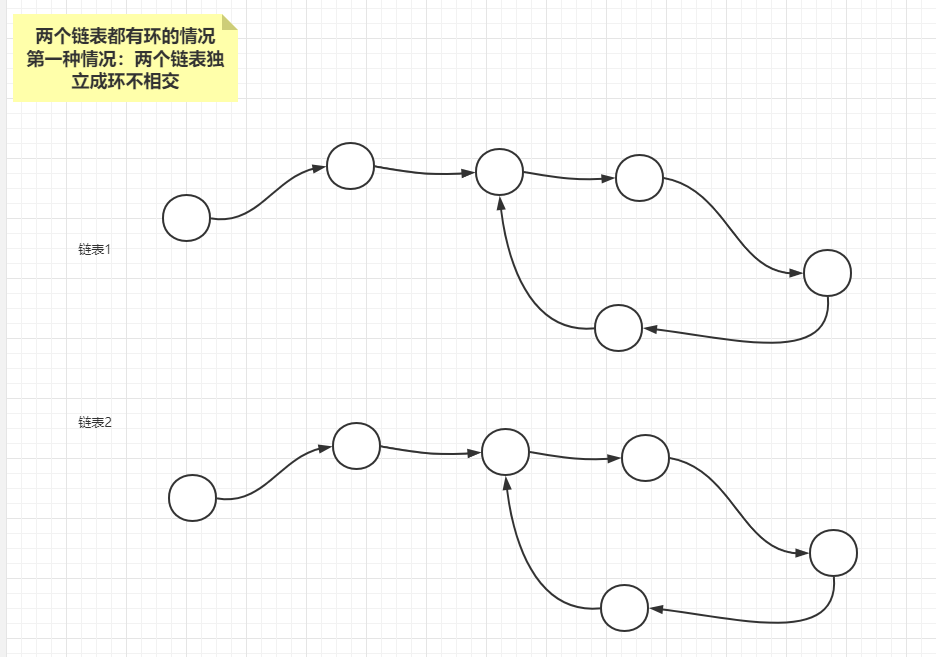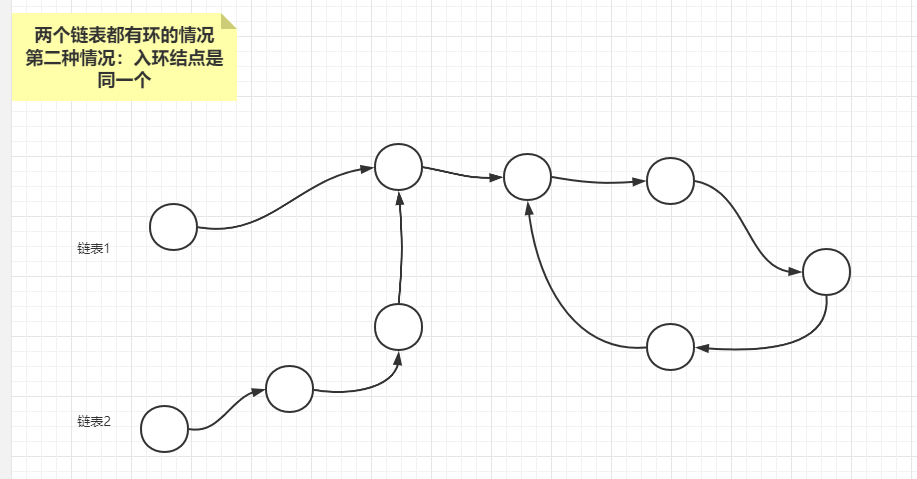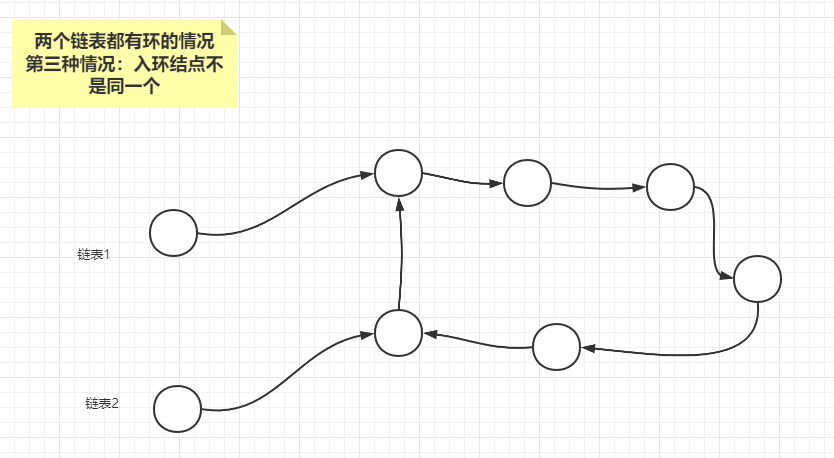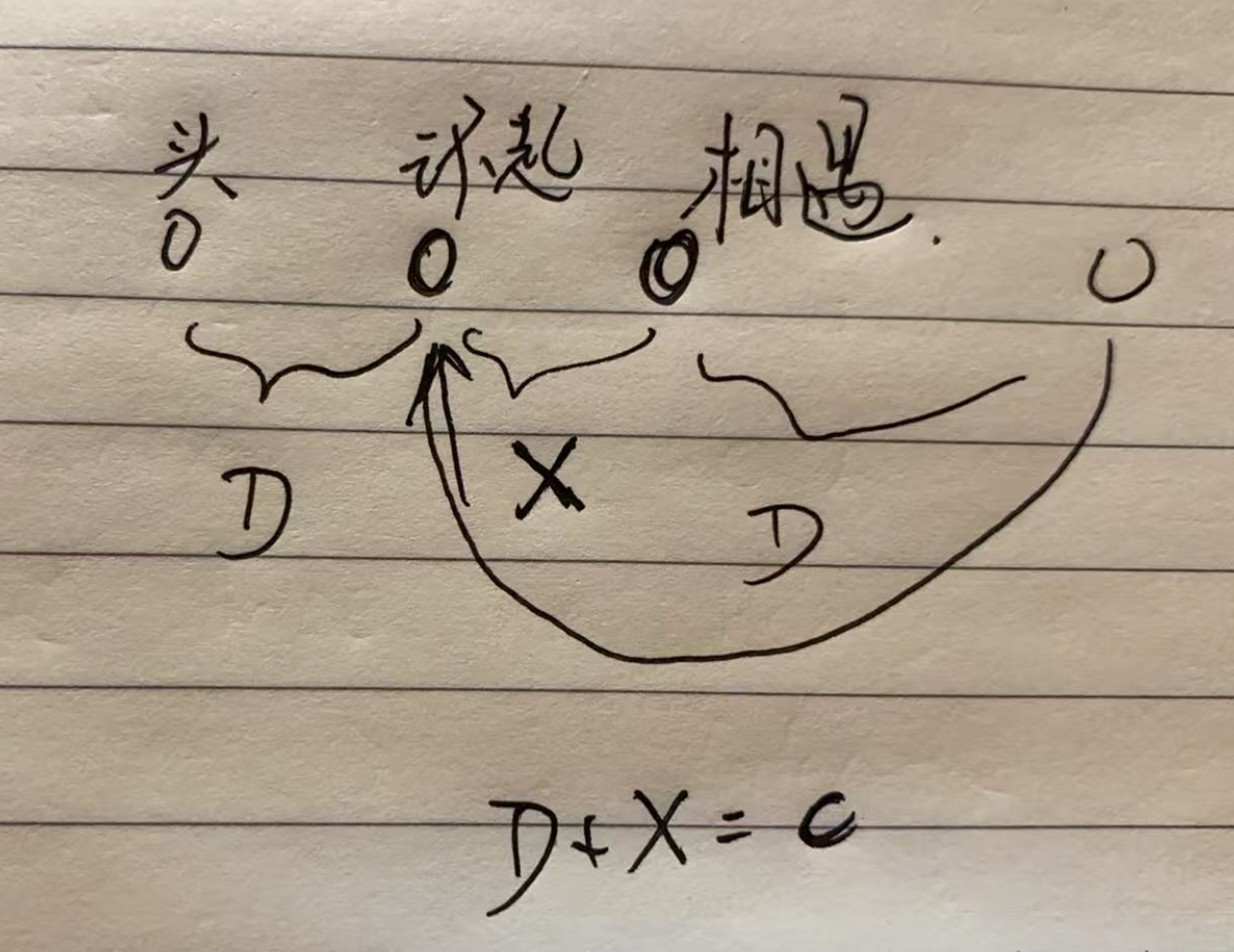1.面试时链表解题的方法论
1)对于笔试,不用太在乎空间复杂度,一切为了时间复杂度
2)对于面试,时间复杂度依然放在第一位,但是一定要找到空间最省的方法
2.链表面试题常用数据结构和技巧
1)使用容器(哈希表、数组等)
2)快慢指针
例如下面的功能:
1)输入链表头节点,奇数长度返回中点,偶数长度返回上中点
2)输入链表头节点,奇数长度返回中点,偶数长度返回下中点
3)输入链表头节点,奇数长度返回中点前一个,偶数长度返回上中点前一个
4)输入链表头节点,奇数长度返回中点前一个,偶数长度返回下中点前一个
这种题目没有什么难度,只是抠边界(考察coding能力的)
3.力扣234回文链表
https://leetcode.cn/problems/palindrome-linked-list/
1
2
3
4
5
6
7
8
9
10
11
12
13
14
15
16
17
18
19
20
21
22
23
24
25
26
27
28
29
30
31
32
33
34
35
36
37
38
39
40
41
42
43
44
45
46
47
48
49
50
51
/**
* Definition for singly-linked list.
* public class ListNode {
* int val;
* ListNode next;
* ListNode() {}
* ListNode(int val) { this.val = val; }
* ListNode(int val, ListNode next) { this.val = val; this.next = next; }
* }
*/
class Solution {
public boolean isPalindrome(ListNode head) {
if (head.next == null) {
return true;
}
int len = listLen(head);
int i = 0;
ListNode pre = null , cur = head, next = null;
while (i < len / 2) {
i++;
next = cur.next;
cur.next = pre;
pre = cur;
cur = next;
}
// pre = 2 cur = 2 len偶数
// pre = 2 cur = 3
if (len % 2 == 1) {
cur = cur.next;
}
while (pre != null) {
if (pre.val != cur.val) {
return false;
}
pre = pre.next;
cur = cur.next;
}
return true;
}
public int listLen(ListNode h) {
int ans = 0;
while (h != null) {
ans++;
h = h.next;
}
return ans;
}
}
4.牛客-链表分隔为3个区域
测试链接:(ACM风格)https://www.nowcoder.com/practice/04fcabc5d76e428c8100dbd855761778
将单向链表按某值划分为左边小,中间相等,右边大的形式
非常类似的题还有力扣86题:https://leetcode.cn/problems/partition-list/description/
题目描述:给你一个链表的头节点
head和一个特定值x,请你对链表进行分隔,使得所有 小于x的节点都出现在 大于或等于x的节点之前。你应当 保留 两个分区中每个节点的初始相对位置。
1)把链表放入数组里,在数组上做partition(笔试用)
2)分成小、中、大三部分,再把各个部分之间串起来(面试用)
下面只展示第二种解法:
1
2
3
4
5
6
7
8
9
10
11
12
13
14
15
16
17
18
19
20
21
22
23
24
25
26
27
28
29
30
31
32
33
34
35
36
37
38
39
40
41
42
43
44
45
46
47
48
49
50
51
52
53
54
55
56
57
58
59
60
61
62
63
64
65
66
67
68
69
70
71
72
73
74
75
76
77
78
79
80
81
82
83
84
85
86
87
88
89
90
91
92
93
94
95
96
97
import java.util.Scanner;
import java.io.*;
class ListNode {
int val;
ListNode next;
public ListNode(int x) {
val = x;
next = null;
}
}
// 注意类名必须为 Main, 不要有任何 package xxx 信息
public class Main {
public static void main(String[] args) throws IOException{
BufferedReader br = new BufferedReader(new InputStreamReader(System.in));
StreamTokenizer in = new StreamTokenizer(br);
PrintWriter out = new PrintWriter(new OutputStreamWriter(System.out));
while (in.nextToken() != StreamTokenizer.TT_EOF) {
int n = (int)in.nval;
in.nextToken();
int v = (int)in.nval;
in.nextToken();
ListNode head = new ListNode((int)in.nval);
in.nextToken();
ListNode cur = head;
for (int i = 1;i < n;i++) {
cur.next = new ListNode((int)in.nval);
in.nextToken();
cur = cur.next;
}
ListNode ans = partition(head, v);
while (ans != null) {
out.print(ans.val + " ");
ans = ans.next;
}
}
out.flush();
br.close();
out.close();
}
public static ListNode partition(ListNode head, int x) {
if(head.next == null) {
return head;
}
ListNode smallHead = null, equalHead = null, biggerHead = null;
ListNode smallCur = null, equalCur = null, biggerCur = null;
ListNode cur = head;
while (cur != null) {
if (cur.val < x) {
if (smallHead == null) {
smallHead = cur;
smallCur = smallHead;
} else {
smallCur.next = cur;
smallCur = smallCur.next;
}
} else if (cur.val == x) {
if (equalHead == null) {
equalHead = cur;
equalCur = equalHead;
} else {
equalCur.next = cur;
equalCur = equalCur.next;
}
} else {
if (biggerHead == null) {
biggerHead = cur;
biggerCur = biggerHead;
} else {
biggerCur.next = cur;
biggerCur = biggerCur.next;
}
}
cur = cur.next;
}
if (smallHead == null) {
if (equalHead == null) {
return biggerHead;
} else {
equalCur.next = biggerHead;
if (biggerCur != null)biggerCur.next = null;
return equalHead;
}
} else {
if (equalHead == null) {
smallCur.next = biggerHead;
if (biggerCur != null) biggerCur.next = null;
} else {
smallCur.next = equalHead;
equalCur.next = biggerHead;
if (biggerCur != null) biggerCur.next = null;
}
return smallHead;
}
}
}
力扣86题解法参考:
1
2
3
4
5
6
7
8
9
10
11
12
13
14
15
16
17
18
19
20
21
22
23
24
25
26
27
28
29
30
31
32
33
34
35
36
37
38
39
40
41
42
43
44
45
46
47
48
49
/**
* Definition for singly-linked list.
* public class ListNode {
* int val;
* ListNode next;
* ListNode() {}
* ListNode(int val) { this.val = val; }
* ListNode(int val, ListNode next) { this.val = val; this.next = next; }
* }
*/
class Solution {
public ListNode partition(ListNode head, int x) {
if (head == null || head.next == null) return head;
ListNode smallHead = null, biggerHead = null;
ListNode smallCur = null, biggerCur = null;
while (head != null) {
if (head.val < x) {
if (smallHead == null) {
smallHead = head;
smallCur = head;
} else {
smallCur.next = head;
smallCur = smallCur.next;
}
} else {
if (biggerHead == null) {
biggerHead = head;
biggerCur = head;
} else {
biggerCur.next = head;
biggerCur = biggerCur.next;
}
}
head = head.next;
}
// 至少2个节点
if (smallHead == null) {
return biggerHead;
} else {
if (biggerHead == null) {
return smallHead;
} else {
smallCur.next = biggerHead;
biggerCur.next = null;
return smallHead;
}
}
}
}
5.力扣138-随机链表的复制
测试链接:138. 随机链表的复制
一种特殊的单链表节点类描述如下
1
2
3
4
5
6
class Node {
int value;
Node next;
Node rand;
Node(int val) { value = val; }
}
rand指针是单链表节点结构中新增的指针,rand可能指向链表中的任意一个节点,也可能指向null。 给定一个由Node节点类型组成的无环单链表的头节点 head,请实现一个函数完成这个链表的复制,并返回复制的新链表的头节点。 【要求】 时间复杂度O(N),额外空间复杂度O(1)
示例 1:

1
2
输入:head = [[7,null],[13,0],[11,4],[10,2],[1,0]]
输出:[[7,null],[13,0],[11,4],[10,2],[1,0]]
示例 2:

1
2
输入:head = [[1,1],[2,1]]
输出:[[1,1],[2,1]]
示例 3:

1
2
输入:head = [[3,null],[3,0],[3,null]]
输出:[[3,null],[3,0],[3,null]]
提示:
\[0 <= n <= 1000\] \[-10^4 <= Node.val <= 10^4\]Node.random 为 null 或指向链表中的节点。
解法1:容器
准备一个Map,key是老节点,value是新节点(这是第一次遍历)。然后第二次遍历,利用哈希表中的映射关系来设置新链表的 next 和 rand 指针。
对于每个老节点 cur:
新节点的 next 指针:map.get(cur).next = map.get(cur.next)。
新节点的 rand 指针:map.get(cur).rand = map.get(cur.rand)。
注意,如果 cur.next 或 cur.rand 为 null,map.get(null) 也会返回 null,这正是我们想要的。
返回头节点: 最后返回新链表的头节点,即 map.get(head)。
1
2
3
4
5
6
7
8
9
10
11
12
13
14
15
16
17
18
19
20
class Solution {
public Node copyRandomList(Node head) {
// 0 <= n <= 1000
if (head == null) return null;
HashMap<Node, Node> map = new HashMap<>();
Node cur = head;
while (cur != null) {
Node newNode = new Node(cur.val);
map.put(cur, newNode);
cur = cur.next;
}
cur = head;
while (cur != null) {
map.get(cur).next = map.get(cur.next);
map.get(cur).random = map.get(cur.random);
cur = cur.next;
}
return map.get(head);
}
}
解法2:不用容器
1
2
3
4
5
6
7
8
9
10
11
12
13
14
15
16
17
18
19
20
21
22
23
24
25
26
27
28
29
30
31
32
class Solution {
public Node copyRandomList(Node head) {
if (head == null) return null;
Node cur = head;
Node next = null;
while (cur != null) {
next = cur.next;
cur.next = new Node(cur.val);
cur.next.next = next;
cur = next;
}
cur = head;
Node copy = null;
while (cur != null) {
next = cur.next.next;
copy = cur.next;
copy.random = cur.random == null ? null : cur.random.next;
cur = next;
}
// 分离
cur = head;
Node res = cur.next;
while (cur != null) {
next = cur.next.next;
copy = cur.next;
cur.next = next;
copy.next = next != null ? next.next : null;
cur = next;
}
return res;
}
}
6.力扣160-相交链表
给定两个可能有环也可能无环的单链表,头节点head1和head2。请实现一个函数,如果两个链表相交,请返回相交的 第一个节点。如果不相交,返回null 【要求】 如果两个链表长度之和为N,时间复杂度请达到O(N),额外空间复杂度 请达到O(1)。
1
2
3
4
5
6
7
8
9
10
public class Solution {
public ListNode getIntersectionNode(ListNode headA, ListNode headB) {
ListNode p1 = headA, p2 = headB;
while (p1 != p2) {
p1 = p1 == null ? headB : p1.next;
p2 = p2 == null ? headA : p2.next;
}
return p1;
}
}
如果要找到第一个相交的节点呢?(容器法:用HashMap就可以,不说了)
同时遍历两个链表到尾部,同时记录两个链表的长度。若两个链表最后的一个节点相同,则两个链表相交。
有两个链表的长度后,我们就可以知道哪个链表长,设较长的链表长度为len1,短的链表长度为len2。
则先让较长的链表向后移动(len1-len2)个长度。然后开始从当前位置同时遍历两个链表,当遍历到的链表的节点相同时,则这个节点就是第一个相交的节点。
测试链接:面试题 02.07. 链表相交
https://leetcode.cn/problems/intersection-of-two-linked-lists-lcci/description/
牛客上也有类似题:https://www.nowcoder.com/practice/bd911c77a1ed4e289a0699fa7df23b6c
https://www.nowcoder.com/practice/6ab1d9a29e88450685099d45c9e31e46
https://www.nowcoder.com/questionTerminal/bd911c77a1ed4e289a0699fa7df23b6c?orderByHotValue=1&page=1&onlyReference=false
1
2
3
4
5
6
7
8
9
10
11
12
13
14
15
16
17
18
19
20
21
22
23
24
25
26
27
28
29
30
31
32
33
34
35
36
37
38
39
40
41
42
43
44
/**
* Definition for singly-linked list.
* public class ListNode {
* int val;
* ListNode next;
* ListNode(int x) {
* val = x;
* next = null;
* }
* }
*/
public class Solution {
public ListNode getIntersectionNode(ListNode headA, ListNode headB) {
if (headA == null || headB == null) return null;
ListNode l1 = headA, l2 = headB;
int m = 0, n = 0;
while (l1.next != null) {
m++;
l1 = l1.next;
}
m++;
while (l2.next != null) {
n++;
l2 = l2.next;
}
n++;
// 判断是否相交
if (l1 != l2) return null;
// 否则相交
int i = 0;
ListNode l = m >= n ? headA : headB;
ListNode s = headA == l ? headB : headA;
while (i < Math.abs(n - m)) {
i++;
l = l.next;
}
//
while (l != s) {
l = l.next;
s = s.next;
}
return l;
}
}
注意:
- 一个链表有环一个链表无环,则两者不可能相交
- 两个链表都有环时,考虑下面3种情况:
- 不相交
- 相交,且在同一个地方相交
- 相交,但不在同一个地方相交
如下图所示3种情况



两个链表的入环结点(loop1,loop2)如果是同一个,可以记录两个链表的差值,然后让长链表先走差值步以后,长短链表同时开始走,相遇的结点就是第一个相交结点。这是3种情况中最简单的。
剩下2 种情况如何判断?让loop1往下走,如果loop1走回到自己都没遇到loop2则属于上面情况1,如果loop1走回到自己之前遇到了loop2则属于情况3
1
2
3
4
5
6
7
8
9
10
11
12
13
14
15
16
17
18
19
20
21
22
23
24
25
26
27
28
29
30
31
32
33
34
35
36
37
38
39
40
41
42
43
44
45
46
47
48
49
50
51
52
53
54
55
56
57
58
59
60
61
62
63
64
65
66
67
68
69
70
71
72
73
74
75
76
77
78
79
80
81
82
83
84
85
86
87
88
89
90
91
92
93
94
95
96
97
98
99
100
101
102
103
104
105
106
107
108
109
110
111
112
113
public static Node getIntersectNode(Node head1, Node head2) {
if (head1 == null || head2 == null) {
return null;
}
Node loop1 = getLoopNode(head1);
Node loop2 = getLoopNode(head2);
if (loop1 == null && loop2 == null) {
return noLoop(head1, head2);
}
if (loop1 != null && loop2 != null) {
return bothLoop(head1, loop1, head2, loop2);
}
return null;
}
// 找到链表第一个入环节点,如果无环,返回null
public static Node getLoopNode(Node head) {
if (head == null || head.next == null || head.next.next == null) {
return null;
}
// n1 慢 n2 快
Node slow = head.next; // n1 -> slow
Node fast = head.next.next; // n2 -> fast
while (slow != fast) {
if (fast.next == null || fast.next.next == null) {
return null;
}
fast = fast.next.next;
slow = slow.next;
}
// slow fast 相遇
fast = head; // n2 -> walk again from head
while (slow != fast) {
slow = slow.next;
fast = fast.next;
}
return slow;
}
// 如果两个链表都无环,返回第一个相交节点,如果不想交,返回null
public static Node noLoop(Node head1, Node head2) {
if (head1 == null || head2 == null) {
return null;
}
Node cur1 = head1;
Node cur2 = head2;
int n = 0;
while (cur1.next != null) {
n++;
cur1 = cur1.next;
}
while (cur2.next != null) {
n--;
cur2 = cur2.next;
}
if (cur1 != cur2) {
return null;
}
// n : 链表1长度减去链表2长度的值
cur1 = n > 0 ? head1 : head2; // 谁长,谁的头变成cur1
cur2 = cur1 == head1 ? head2 : head1; // 谁短,谁的头变成cur2
n = Math.abs(n);
while (n != 0) {
n--;
cur1 = cur1.next;
}
while (cur1 != cur2) {
cur1 = cur1.next;
cur2 = cur2.next;
}
return cur1;
}
// 两个有环链表,返回第一个相交节点,如果不想交返回null
public static Node bothLoop(Node head1, Node loop1, Node head2, Node loop2) {
Node cur1 = null;
Node cur2 = null;
if (loop1 == loop2) {
cur1 = head1;
cur2 = head2;
int n = 0;
while (cur1 != loop1) {
n++;
cur1 = cur1.next;
}
while (cur2 != loop2) {
n--;
cur2 = cur2.next;
}
cur1 = n > 0 ? head1 : head2;
cur2 = cur1 == head1 ? head2 : head1;
n = Math.abs(n);
while (n != 0) {
n--;
cur1 = cur1.next;
}
while (cur1 != cur2) {
cur1 = cur1.next;
cur2 = cur2.next;
}
return cur1;
} else {
cur1 = loop1.next;
while (cur1 != loop1) {
if (cur1 == loop2) {
return loop1;
}
cur1 = cur1.next;
}
return null;
}
}
7.环形链表
测试链接:https://leetcode.cn/problems/linked-list-cycle-ii/
数学证明如下:
需要利用数学知识:
相遇时的情况:
- 假设链表头到环起点的距离为 ( D )。
- 环的长度为 ( C )。
- slow 和 fast 在环内的某个点相遇,设相遇点到环起点的距离为 ( X )。
关键观察:
-
当相遇时,slow 走的总距离为
D + X。 -
fast 走的总距离为 \(D + X + k \cdot C\)(因为 fast 可能在环中多跑了几圈,( k ) 是圈数)。
-
由于 fast 的速度是 slow 的 2 倍,( fast ) 走的距离是 ( slow ) 的 2 倍:\(D + X + k \cdot C = 2 \cdot (D + X)\)
-
化简:
\[D + X + k \cdot C = 2D + 2X\] \[k \cdot C = D + X\] \[D = k \cdot C - X\] -
这表明:从链表头到环起点的距离 ( D ) 和相遇点到环起点的距离(通过环内的路径)有关系。
找到环起点的方法:
- 当 slow 和 fast 相遇后:
- 将一个指针(比如 slow)放回链表头部。
- 另一个指针(fast)留在相遇点。
- 两个指针以相同速度(每次 1 步)移动。
- 它们会在环的起点相遇。
为什么有效:
- 从链表头到环起点走 ( D ) 步。
- 从相遇点回到环起点(沿环走剩余部分),距离为
C - X(环长减去相遇点到起点的距离)。 - 根据公式 \(D = k \cdot C - X\):
- 如果
k = 1,则D = C - X。 - 两个指针同时走 ( D ) 步:
- 从头走的指针到达环起点。
- 从相遇点走的指针沿环走
C - X,正好回到环起点。
- 如果
- 因此,它们一定在环起点相遇。(见下图,画的比较抽象)

1
2
3
4
5
6
7
8
9
10
11
12
13
14
15
16
17
18
19
20
21
22
23
24
25
26
27
28
29
/**
* Definition for singly-linked list.
* class ListNode {
* int val;
* ListNode next;
* ListNode(int x) {
* val = x;
* next = null;
* }
* }
*/
public class Solution {
public ListNode detectCycle(ListNode head) {
ListNode q = head, s = head;
while (q != null && q.next != null && q.next.next != null) {
q = q.next.next;
s = s.next;
if (q == s) {
q = head;
while (q != s) {
q = q.next;
s = s.next;
}
return q;
}
}
return null;
}
}
8.环形链表(续)
能不能不给单链表的头节点,只给想要删除的节点,就能做到在链表上把这个点删掉?返回头部(万一要删除的是头部节点)
面试如果真的问这个,也是想问他说的内个抖机灵的做法(将要删除的下一个节点的值给当前这个节点,然后调节当前节点的next指针)。
示例: 链表: A→B→C→D→E 要删除 C(只知道 C)
- 复制 D 的值到 C。 链表变成: A→B→D→D→E (节点 C 存储了 D 的值)
- C.next=D.next (指向 E) 链表变成: A→B→D→E
节点 D 被成功移除了,链表保持了 A→B→D→E 的逻辑顺序。
至于最后一个节点怎么办,确实是没有办法的,解释如下。
抖机灵的办法无法完成一种情况:删除链表最后一个节点。null是系统上一个独立的区域。比如1->2->null。如果你要删掉2。你需要找到1,然后将1.next指向这个区域。不是说你把2变成null,你变不成。你就是变成了,1的next也没有指向公认的null的区域。